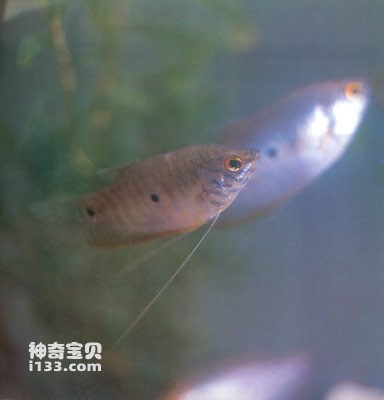Trichogaster trichopterus is also known as the hairy-footed perch. Belongs to the order Perciformes, family Bettaidae, and the genus Nephilus. Commonly known as: wood slag fish, sapphire, big spaceship, Indian fighting fish, big walnut. English name: Giant gouramy, Spotted gourami, Bluegourami.
Endangerment level: Vulnerable.
The body is nearly oval, extremely flat on the sides, and the starting point of the dorsal fin is the highest point of the body. The head is small, and the head is much smaller than the body height. The snout is blunt and rounded, and its length is smaller than the diameter of the eye. The cleft of the mouth is small, located upward, and the mandible is protruding. Lips slightly developed. The eyes are larger and located in the front half of the head. The lower edge of the preorbital bone is free and serrated. The outer edge of the operculum is also finely serrated. The head and body are covered with large comb scales. The lateral line scales are 35-39, and the lateral line curves sharply downward from the vertical line to the origin of the dorsal fin, and is laterally midpoint to the tail. The dorsal fin has 7 hard spines; the anal fin has 10-13 hard spines and 31-37 fin rays; the pectoral fin is round; the pelvic fin is in the pectoral position, the fin spines are degenerated, and the first fin ray is long filamentous and can extend past the base of the caudal fin; Caudal fin forked. The body color is bright, the base color is silvery white with green luster. There are many blue diagonal stripes from the snout to the base of the caudal fin; there are 1 blue round spot in the center of the body side and at the base of the caudal fin. There are many bright blue spots on the back, buttocks and tail fin. The male fish has a darker body color and a square and long dorsal fin.
Mainly inhabits ponds, rivers, lakes, ditches and other still water environments with many aquatic plants. Strong adaptability to environmental life and strong physique. Staple food plankton. The reproductive period is from March to April. The male fish spits out foam and mixes it with crushed grass to form a spawning ovary that floats on the water. Small, colorful and easy to raise, it is one of the most common tropical ornamental fish in the world.
Domestically, it is distributed in the lower reaches of the Lancang River in Xishuangbanna, Yunnan; abroad, it is distributed throughout Southeast Asia.
There were originally a certain number in its distribution area and were relatively common. In recent years, due to the significant reduction in water volume, most of the small rivers, ditches, and ponds in its habitat have dried up. In addition, some ponds are mostly used to raise domestic fish. However, this fish has no food value and has been cleared away. The current number has been significantly reduced.

animal tags:
We created this article in conjunction with AI technology, then made sure it was fact-checked and edited by a Animals Top editor.